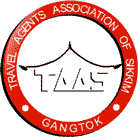|
 
Places of
Interest:
Paro:
The first thing you will notice as you
disembark is the transparent purity of air and the
absence of noise. The Paro Valley has kept its
bucolic nature in spite of the airport and the
existence of development projects. Fields, brown
or green depending on the season, cover most of
the valley floor, while hamlets and isolated farms
dot the countryside. The houses of Paro Valley are
considered to be among the most beautiful in the
country. Paro is believed to be one of the first
valleys to have received the imprint of
Buddhism
Places to visit in
Paro
-
Kyichu Lhakhang [Lhakhang
means Temple]
-
Taksang Monastery (Tiger's
Nest)
-
Drugyel Dzong [Dzong means
Fortress]
-
Dungtse Lhakhang
-
Ta Dzong
[National Museum]
-
Paro Dzong
Thimphu:
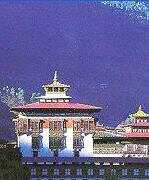 Thimphu lies in
a wooded valley, sprawling up a hillside on the
West Bank of the Thimphu Chhu [Chhu means River].
Thimphu is unlike any other world capital. Small
and secluded the city is quiet and there are never
the traffic jams familiar in other Asian Capitals.
It is often said that Thimphu is the only world
capital without traffic lights. Thimphu's main
shopping street is a delight not so much for what
you can buy there, but for the picturesqueness of
the architecture and national costume. Beautiful
weaves in wool, silk and cotton, basketwork,
silver jewelry, thangkas and other traditional
crafts of the Kingdom are available in various
Handicraft Emporiums. Thimphu lies in
a wooded valley, sprawling up a hillside on the
West Bank of the Thimphu Chhu [Chhu means River].
Thimphu is unlike any other world capital. Small
and secluded the city is quiet and there are never
the traffic jams familiar in other Asian Capitals.
It is often said that Thimphu is the only world
capital without traffic lights. Thimphu's main
shopping street is a delight not so much for what
you can buy there, but for the picturesqueness of
the architecture and national costume. Beautiful
weaves in wool, silk and cotton, basketwork,
silver jewelry, thangkas and other traditional
crafts of the Kingdom are available in various
Handicraft Emporiums.
Places to
visit in Thimphu
-
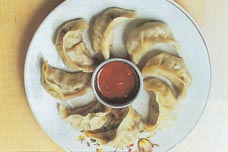 The Memorial Chorten [Chorten means Stupa] The Memorial Chorten [Chorten means Stupa]
-
Changlimithang
[Battle Ground]
-
Weekly Market [Saturdays and
Sundays]
-
Tashichoe Dzong [The biggest
fortress in Bhutan]
-
National
Library
-
School of Arts and Crafts
-
Royal
Academy of Performing Arts
-
National Institute
of Traditional Medicine
-
Zangto Pelri
Lhakhang
-
Zoo
-
Changangkha
Lhakhang
-
Drubthob Goemba
[Nunnery]
-
Dechencholing Palace
-
Pangri
Zampa Temple
-
Tango Goemba
-
Chari
Goemba
-
Simthoka
Dzong
Recommended day hikes in
Thimphu
-
Tala
Monastery
-
Phajoding
Monastery
-
Thadra
Monastery
-
Trashigang
Nunnery
Punakha:
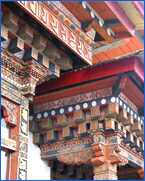 Rinchen
build a temple there which can still be seen today
opposite to the great Dzong. Shabdrung Nawang
Namgyel a key figure in the History of Bhutan
built the Punakha Dzong and his body is preserved
in one of the Dzongs temples, Machen Lhakhang. The
Dzong was damaged six times by fire, once by
floods and once by earthquake. The coronation of
Ugyen Wangchuk, the first king of Bhutan, took
place at Punakha Dzong on 17th December
1907. Rinchen
build a temple there which can still be seen today
opposite to the great Dzong. Shabdrung Nawang
Namgyel a key figure in the History of Bhutan
built the Punakha Dzong and his body is preserved
in one of the Dzongs temples, Machen Lhakhang. The
Dzong was damaged six times by fire, once by
floods and once by earthquake. The coronation of
Ugyen Wangchuk, the first king of Bhutan, took
place at Punakha Dzong on 17th December
1907.
Places to visit in
Punakha
Wandue Phodrang:
Meaning “the palace where
the four directions are gathered under the power
of the Shabdrung”. However the popular story has
it that the Shabdrung arrived at the river and
happened to see a boy building a sand castle. He
asked for the boy's name, which was Wangdue, and
thereupon decided to name the Dzong Wangdue
Phodrang or 'Wangdue's Palace.' Wangdue Phodrang
Dzong is perched on a spur at the confluence of 02
rivers. The position of the Dzong is remarkable as
it completely covers the spur and commands an
impressive view over both the north-south and
east-west roads. The main road climbs the length
of the spur and on the left, across the river,
comes the first glimpse of the picturesque village
of Rinchengang whose inhabitants are celebrated
stonemasons.
Phuntsoling:
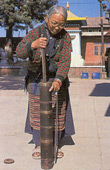 This
small modern town in the south is the gateway of
Bhutan for overland travelers. Like all other
border towns, it is also a prelude. Phuntsholing
is also a fascinating mixture of Bhutanese and
Indian, a lively center for the mingling people,
languages, customs and goods. On top of a low hill
at nearby Kharbandi, a small Gompa situated in a
garden of tropical plants and flowers overlooks
the town and surrounding plains. This
small modern town in the south is the gateway of
Bhutan for overland travelers. Like all other
border towns, it is also a prelude. Phuntsholing
is also a fascinating mixture of Bhutanese and
Indian, a lively center for the mingling people,
languages, customs and goods. On top of a low hill
at nearby Kharbandi, a small Gompa situated in a
garden of tropical plants and flowers overlooks
the town and surrounding plains.
The Amo
Chu, commonly known as the Torsa river flows
alongside this town and it is favorite spot for
fisherman and the picnickers. From Phuntsholing,
the road winds north over the southern foothills,
through lush forested valleys and around the
rugged north-south ridges of the inner Himalayas
to the central valleys of Thimphu and Paro. It is
a scenic journey; forests festooned with orchids
cover the mountains on the other side and exciting
hairpin curves greet travelers with colorful
sculptures of Tashi Tagye (The eight auspicious
signs of Buddhism).
Trongsa:
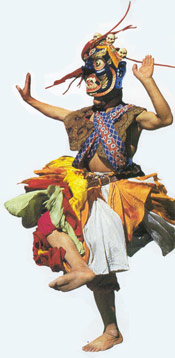 Trongsa means
'the new village' and the founding of Trongsa
first dates from the 16th century which is indeed
relatively recent for Bhutan. It was the Drukpa
lama, Ngagi Wangchuk (1517-54), the great
grandfather of Shabdrung Nawang Namgyel, who
founded the first temple at Trongsa in 1543. The
landscape around Trongsa is spectacular, and for
miles on the end the Dzong seems to tease you so
that you wonder if you will ever reach Trongsa.
The view extends for many kilometers and in the
former times, nothing could escape the vigilance
of its watchmen. Trongsa means
'the new village' and the founding of Trongsa
first dates from the 16th century which is indeed
relatively recent for Bhutan. It was the Drukpa
lama, Ngagi Wangchuk (1517-54), the great
grandfather of Shabdrung Nawang Namgyel, who
founded the first temple at Trongsa in 1543. The
landscape around Trongsa is spectacular, and for
miles on the end the Dzong seems to tease you so
that you wonder if you will ever reach Trongsa.
The view extends for many kilometers and in the
former times, nothing could escape the vigilance
of its watchmen.
Places to
visit in Trongsa
Bumthang:
The
Bumthang region encompasses four major valleys:
Choskhor, Tang, Ura and Chhume. The Dzongs and the
most important temples are in the large Choskhor
valley, commonly referred to as Bumthang
valley.
There are two versions of the origin of the
name Bumthang. The valley is supposed to be shaped
like a Bumpa, a vessel that contains holy water,
and Thang meaning flat place. The religious
connotation of the name aptly applies to the
sacred character of the region. It would be
difficult to find so many important temples and
monasteries in such a small area anywhere else in
Bhutan.
Places to visit in
Bhumthang
-
Jakar Dzong [Castle of
the White Bird]
-
Wangdichholing
Palace
-
Lamey Goemba
-
Kurje Lhakhang [Ku
means "body", Je means "imprint"]
-
Tamshing
Lhakhang [Temple of Good Message]
-
Kencho Sum Lhakhang [known for its broken bell]
-
Member
Tsho
-
Peling Sermon Chorten
[Stupa]
Mongar:
The
Mongar district is the northern portion of the
ancient region of Kheng. Mongar is the district
headquarters and hardly more than a stopping place
surrounded by fields of maize. It is also the
first town built in a mountain side instead of in
a valley, a characteristic of eastern Bhutan where
the valleys are usually little more than riverbeds
and mountain slopes which rise abruptly from the
rivers, flatten out as they approach their
summits. One would never imagine that the upper
parts of the mountains are so densely
populated.
Shongar Dzong, Mongar's original Dzong, is in
ruins and the new dzong in Mongar town is not as
architecturally spectacular as others in the
region. Dramtse Goemba, in the eastern part of the
district, is an important Nyingmapa Monastery, but
it is difficult to get
there.
Places to visit in
Mongar
1.Dramtse
Goemba
2.Mongar
Dzong
Lhuentse:
Lhuentse
is an isolated district although there are many
sizeable villages in the hill throughout the
region. It is very rural and there are fewer than
five vehicles, including an ambulance, and not a
single petrol station, in the whole district.
Formerly known as Kurtoe, the region is the
ancestral home of Bhutan's Royal Family. Though
geographically in the east, it was culturally
identified with central Bhutan, and the route over
the Rodung-la was a major trade route until the
road to Mongar was completed. To see and
appreciate Lhuentse properly, with its many small
villages and ancient temples, you should really
explore on foot.
Trashigang:
Trashigang
is one of the most densely populated districts in
Bhutan. After Thimphu, Trashigang is the biggest
urban center in mountainous Bhutan. It is the
heart of eastern Bhutan and was once the center of
important trade with Tibet. There are several
goembas and villages that make a visit worthwhile,
but it is a remote region and requires a lot of
driving to reach.
Places to visit
in Trashigang
Samdrup Zonkhar:
The small frontier town
is situated at the precise point where the
mountains meet the plains. There is almost nothing
of interest to the traveler in south-eastern
Bhutan. It is the headquarters of a district
boasting a brand new Dzong, although it is
basically a town of small shopkeepers who serve
all of eastern Bhutan as far as Mongar and
Lhuntshi. The tropical heat gives a languid air
which is accentuated by a lack of busy traffic.
Top
|

 Thimphu lies in
a wooded valley, sprawling up a hillside on the
West Bank of the Thimphu Chhu [Chhu means River].
Thimphu is unlike any other world capital. Small
and secluded the city is quiet and there are never
the traffic jams familiar in other Asian Capitals.
It is often said that Thimphu is the only world
capital without traffic lights. Thimphu's main
shopping street is a delight not so much for what
you can buy there, but for the picturesqueness of
the architecture and national costume. Beautiful
weaves in wool, silk and cotton, basketwork,
silver jewelry, thangkas and other traditional
crafts of the Kingdom are available in various
Handicraft Emporiums.
Thimphu lies in
a wooded valley, sprawling up a hillside on the
West Bank of the Thimphu Chhu [Chhu means River].
Thimphu is unlike any other world capital. Small
and secluded the city is quiet and there are never
the traffic jams familiar in other Asian Capitals.
It is often said that Thimphu is the only world
capital without traffic lights. Thimphu's main
shopping street is a delight not so much for what
you can buy there, but for the picturesqueness of
the architecture and national costume. Beautiful
weaves in wool, silk and cotton, basketwork,
silver jewelry, thangkas and other traditional
crafts of the Kingdom are available in various
Handicraft Emporiums. The Memorial Chorten [Chorten means Stupa]
The Memorial Chorten [Chorten means Stupa] Rinchen
build a temple there which can still be seen today
opposite to the great Dzong. Shabdrung Nawang
Namgyel a key figure in the History of Bhutan
built the Punakha Dzong and his body is preserved
in one of the Dzongs temples, Machen Lhakhang. The
Dzong was damaged six times by fire, once by
floods and once by earthquake. The coronation of
Ugyen Wangchuk, the first king of Bhutan, took
place at Punakha Dzong on 17th December
1907.
Rinchen
build a temple there which can still be seen today
opposite to the great Dzong. Shabdrung Nawang
Namgyel a key figure in the History of Bhutan
built the Punakha Dzong and his body is preserved
in one of the Dzongs temples, Machen Lhakhang. The
Dzong was damaged six times by fire, once by
floods and once by earthquake. The coronation of
Ugyen Wangchuk, the first king of Bhutan, took
place at Punakha Dzong on 17th December
1907. This
small modern town in the south is the gateway of
Bhutan for overland travelers. Like all other
border towns, it is also a prelude. Phuntsholing
is also a fascinating mixture of Bhutanese and
Indian, a lively center for the mingling people,
languages, customs and goods. On top of a low hill
at nearby Kharbandi, a small Gompa situated in a
garden of tropical plants and flowers overlooks
the town and surrounding plains.
This
small modern town in the south is the gateway of
Bhutan for overland travelers. Like all other
border towns, it is also a prelude. Phuntsholing
is also a fascinating mixture of Bhutanese and
Indian, a lively center for the mingling people,
languages, customs and goods. On top of a low hill
at nearby Kharbandi, a small Gompa situated in a
garden of tropical plants and flowers overlooks
the town and surrounding plains. Trongsa means
'the new village' and the founding of Trongsa
first dates from the 16th century which is indeed
relatively recent for Bhutan. It was the Drukpa
lama, Ngagi Wangchuk (1517-54), the great
grandfather of Shabdrung Nawang Namgyel, who
founded the first temple at Trongsa in 1543. The
landscape around Trongsa is spectacular, and for
miles on the end the Dzong seems to tease you so
that you wonder if you will ever reach Trongsa.
The view extends for many kilometers and in the
former times, nothing could escape the vigilance
of its watchmen.
Trongsa means
'the new village' and the founding of Trongsa
first dates from the 16th century which is indeed
relatively recent for Bhutan. It was the Drukpa
lama, Ngagi Wangchuk (1517-54), the great
grandfather of Shabdrung Nawang Namgyel, who
founded the first temple at Trongsa in 1543. The
landscape around Trongsa is spectacular, and for
miles on the end the Dzong seems to tease you so
that you wonder if you will ever reach Trongsa.
The view extends for many kilometers and in the
former times, nothing could escape the vigilance
of its watchmen.